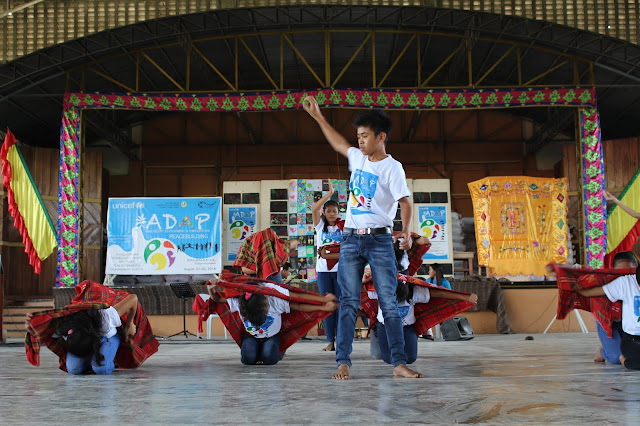ADAP-PB(Adolescent Development and
Participation-Peacebuilding)
Fostering
Peacebuilding & Child Protection through Culture & Arts
UNICEF
Program
Implementor:
Kalimudan Culture and Arts Center
Introduction
and Rationale
ADAP-PB (Adolescent Development and
Participation-Peacebuilding)
“Fostering Peacebuilding & Child
Protection through Culture & Arts” is a UNICEF Program
with Kalimudan Culture and Arts Center
of General Santos City as implementing partner that will cover areas of Maitum,
Sarangani Province, Kalamansig, Sultan Kudarat and Mamasapano, Maguindanao from
August to October of 2016.
This project will aim to create spaces for children and the youth and
enhance their capacity to participate in decision-making, as well it envisions
to create an ‘Advocacy for Gatekeepers’ and establish ‘Participatory Creative
Processes: Exploring Conflict and Peacebuilding’—instituting ‘Safe Spaces’ that
will employ creative participatory and cultural expressions for children and
youth that would be able to discuss and explore specific themes on conflict and
peacebuilding such as, identity, culture, history, narratives, respect and
diversity through their perspectives, experiences and roles related to these
themes.
Mindanao Children in Conflict
Affected Communities
Throughout Mindanao’s
history of peace and conflict, children (and adolescents) are amongst those who
have suffered the most, facing direct exposure to violence,
displacement, continuing poverty or the loss of loved ones. They are faced with
poor nutrition and hygienic conditions, inadequate shelter, and a lack of basic
services, and putting them at risk of disease. Some
30,000 to 50,000 children in Mindanao are displaced annually, according F
figures shared by the Philippine Legislators' Committee on Population and
Development Foundation, Inc. (PLCPD). In addition between January and June 2015
nearly 50 incidents of Grave Child Rights Violations (GCRV) were reported
across Mindanao, affecting over 3,100 children. Some of the highest levels of
poverty are found in the Autonomous Region of Muslim Mindanao (ARMM), where 4
out of 10 children will not reach their optimal height due to chronic
malnutrition and less than 4 out of every 10 children that start elementary
school complete it compared to a national average of 7 out of 10 in the
Philippines. Whilst there are pockets of economic growth, many areas in
Mindanao are extremely poor, with over half of the population living below the
poverty line. These stark disparities are driven to a large degree by the
conflict, which has killed hundreds of thousands, forced millions from their
homes, and disrupted children’s access to schools, hospitals and other basic
services.
Children’s Participation in
Peacebuilding using Culture and Art forms
& Relevance to UNICEF’s
Programmatic Priorities
Promoting the survival and well-being
of children in Mindanao is one of UNICEF’s key priorities. There is also broad understanding that to be
successful, peacebuilding should: address root causes of the conflict; enhance
social cohesion (society-society relationships); build trust in governments
(state-society relationships); and build capacity of individuals, communities
and institutions to manage conflict and deliver services. Within this general
framework, UNICEF’s programme aims to create space for young people and enhance
their capacity to participate in decision-making linked to the Government of
the Republic of the Philippines (GRP) and Moro Islamic Liberation Front (MILF)
peace process and local level peacebuilding, whilst simultaneously promoting
non-violent, pro-peace knowledge, attitudes and behaviours.
The quest for peace is integral to the fulfillment of
children’s rights, including their rights to physical safety, health and
wellbeing. Children, boys and girls can be active key players/part of the
solution. When utilized properly, they can be very important part of re-building
and healing. Young people have distinct experiences in armed conflict, distinct
needs and distinct capacities for recovering and contributing to
peace-building: They mentor and tutor other children and provide friendship and
companionship for one another. Children and young people and the contributions
they can make are therefore a major part of the solution, yet if
neglected/forgotten can also be/become part of the problem. Experience in
countries where demobilization exercises and justice sector reforms have
neglected to include children has shown that this lack of attention not only
has a negative effect for young people themselves, but can be detrimental to
the peace building effort (child soldiers, juvenile crime etc.) Recognizing
that all children have the same rights everywhere at all times, including in
times of conflict and post-conflict transition, children’s rights and concerns
should be integrated within all phases of peacemaking, peacekeeping and peace
building activities, including early warning, prevention and recovery.
Harnessing the
strategies of Child Protection and Peacebuilding, this project hopes to
contribute to the attainment of the following outcomes:
- Strengthened mechanisms for promoting the rights
of children in peace process and situations
of armed conflict and supporting
the participation of children in Peacebuilding
- Strengthened
capacity of transitional actors to deliver key services to children at
risk of association and recruitment by armed groups
Using culture and arts as tools, the project supports selected communities to create a violence-free home environment,
and helps girls and boys, including adolescents, to promote a culture of peace.
In addition it contributes to the development of children's creativity,
appreciation of tradition and culture to foster peace.





























